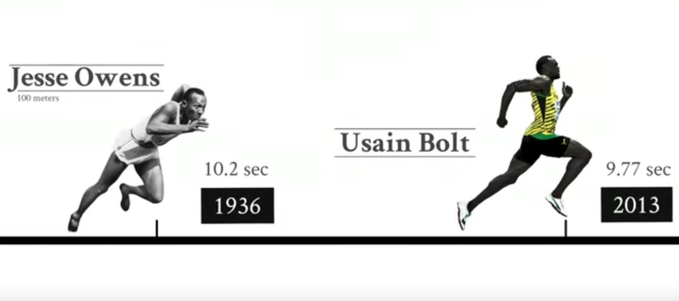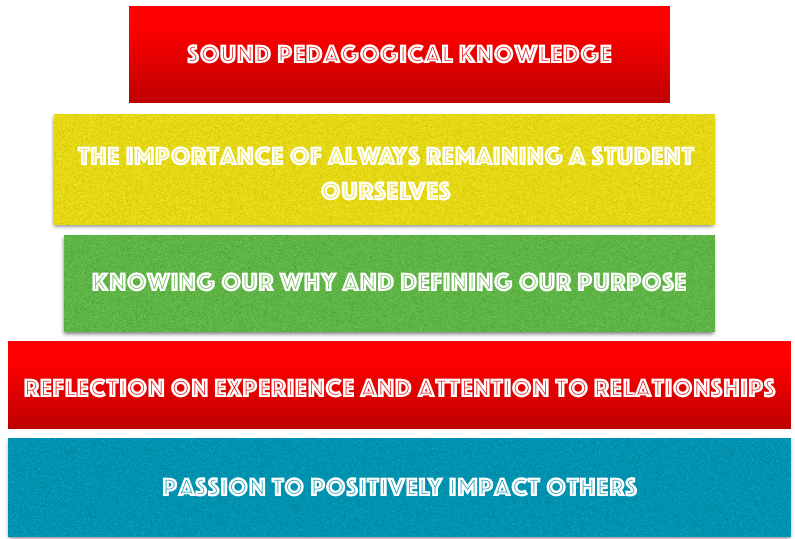|
I came across a great Ted Talk given by David Epstein, an investigative reporter, who writes about the colliding worlds of sports, science and medicine. In a Ted Talk that he gave in 2014 in Vancouver, Canada, David shares the work of Ross Tucker, a Professor of Exercise Physiology at Free State University in South Africa. In his talk, he describes a demonstration that Ross conceived that compares the actual speed that both Jesse Owens and Usain Bolt ran in their world record performances in 1936 and in 2013. Tucker’s aim was to help dispel a myth that modern day athletes are far faster, stronger, and superior to athletes of the past (using track and field as a reference point). In 1936 Jesse Owens set a world record in the 100m by running it in 10.2 seconds. In 2013 Usain Bolt ran the 100m in 9.77 seconds. To drill home his point, Ross Tucker devised a make-believe race in which Jesse Owens and Usain Bolt ran against one another and in the race, beeps are used to identify exactly when each runner crosses the finish line. When you listen to this race at normal speed, the beeps sound at almost exactly the same time as the two cross the finish line. Despite the beeps being so close together, Ross Tucker was able to determine that Jesse Owens would have been about 14 feet behind Bolt which is actually quite a gap in regards to the 100m sprint. In modern day Olympic competitions, Owens wouldn’t even have qualified for the finals of the 100m. Although it seems as though Usain Bolt is a far superior sprinter than what Jesse Owens was, Tucker sets out to disqualify this judgement and does so by comparing the technology that was available to each runner at the time of their world record race. Consider this……. Jesse Owens had to use a garden trowel to dig out holes in the track in order to propel himself out of. As well, he ran the race on a cinder track which was a surface consisting of ash made from burnt wood. As Epstein explains in his Ted Talk, the cinder track stole vast amounts of energy from him as he sprinted toward the finish line. Tucker conducted a biomechanical analysis of the speed of Owens’ joints and determined that had Jesse run on the same track as Usain Bolt, using the same technology that Bolt had access to , he would’ve finished a mere step behind him not 14 feet. Obviously even by today’s standards Jesse Owens would be a world class sprinter, ranking right up there with the likes of Usain Bolt and other top Olympians. When looking at the Owens/Bolt story above, I would argue that the analogy stays the same in the examination of teaching. When filtered down to the bare essence of teaching, what separates the good from the great or the not good from the average? It is commonplace to assume at times that teachers who have an abundance of technology and resources available to them ultimately have a greater impact on those who they teach. I would argue that some of the technology being used nowadays is necessary for teaching, just as certain technologies have allowed modern day athletes like Bolt to own the world of sprinting. However, when considering what good teaching means, I would make a case that when we remove all the glitz, glam, bells and whistles that we sometimes tend to roll out in our practice, we are left with only our teacher selves. At this point, we must evaluate what is most important in making a difference to becoming the teachers that we want to be. Just as the timeless art of good sprinting hasn’t changed that much over the decades, neither have the factors related to our pursuit of mastery in teaching. I recently contacted a number of researcher friends of mine from around the world to ask them to define what they believe to be the keys to mastery in teaching and they all got back to me with varying perspectives on this question. At the heart of it though, there were definitely some commonalities. Having access to technology and an abundance of resources, without question, can help to better our teaching, but when we get right down to the bare essence of what good teaching means, it must begin with us. The keys to success in teaching are within our grasp if we always maintain the desire to learn and grow, to form positive relationships with our students (and colleagues), and continually work to define our purpose. If we were to look back in time at teaching over the years, examining what made great teachers excellent at what they do, I’m sure we would find the very same fundamentals and keys to success in place; a desire to learn and grow, the ability to form positive relationships, and a clarity of purpose. Layering in all the extras in our teaching is an essential part of our job, especially if these extras enhance student learning. However, we must not lose sight of the key fundamentals to success that lie at the very core of great teaching.
3 Comments
Marina Gijzen
1/22/2016 06:49:28 pm
Nice analogy Andy. This was a good read. Thanks.
Reply
Leave a Reply. |
AuthorKAUST Faculty, Pedagogical Coach. Presenter & Workshop Leader.IB Educator. #RunYourLife podcast host. Archives
September 2022
|
- Welcome
- All Things Teaching and Learning
- The Aligned Leader Blog
- Consulting and Coaching Opportunities
- My TED X Talk
- My Leadership Blog
- Run Your Life Podcast Series
- How PYP PE with Andy Has Helped Others
- Good Teaching is L.I.F.E
- The Sportfolio
- Example Assessment Tasks
- PYP Attitude Posters (printable)
- Publications


 RSS Feed
RSS Feed
